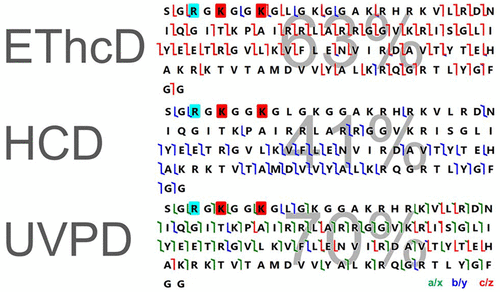当前位置:
X-MOL 学术
›
J. Proteome Res.
›
论文详情
Our official English website, www.x-mol.net, welcomes your
feedback! (Note: you will need to create a separate account there.)
Top-Down Characterization of Heavily Modified Histones Using 193 nm Ultraviolet Photodissociation Mass Spectrometry
Journal of Proteome Research ( IF 3.8 ) Pub Date : 2018-01-31 00:00:00 , DOI: 10.1021/acs.jproteome.7b00801 Sylvester M. Greer 1 , Jennifer S. Brodbelt 1
Journal of Proteome Research ( IF 3.8 ) Pub Date : 2018-01-31 00:00:00 , DOI: 10.1021/acs.jproteome.7b00801 Sylvester M. Greer 1 , Jennifer S. Brodbelt 1
Affiliation

|
The characterization of protein post-translational modifications (PTMs) remains a significant challenge for traditional bottom-up proteomics methods owing to the lability of PTMs and the difficulty of mapping combinatorial patterns of PTMs based on analysis of small peptides. These shortcomings have accelerated interest in top-down MS/MS methods that focus on analysis of intact proteins. Simultaneous mapping of all PTMs requires extensive sequence coverage to confidently localize modifications. 193 nm ultraviolet photodissociation (UVPD) has been shown to generate unparalleled sequence coverage for intact proteins compared to traditional MS/MS methods. This study focuses on identification and localization of PTMs of histones by UVPD, higher-energy collisional dissociation (HCD), and the hybrid method electron-transfer/higher-energy collision dissociation (EThcD) via a high throughput liquid chromatography–mass spectrometry strategy. In total, over 500 proteoforms were characterized among these three activation methods with 46% of the identifications found in common by two or more activation methods. EThcD and UVPD afforded more extensive characterization of proteoforms than HCD with average gains in sequence coverage of 15% and C-scores that doubled on average.
中文翻译:

使用193 nm紫外光解离质谱法自重修饰组蛋白的自上而下的表征
由于PTM的不稳定性以及难以基于小肽分析绘制PTM组合模式的图谱,蛋白质翻译后修饰(PTM)的表征仍然是传统的自下而上的蛋白质组学方法面临的重大挑战。这些缺点引起了人们对自上而下的MS / MS方法的关注,该方法侧重于完整蛋白的分析。所有PTM的同时映射需要广泛的序列覆盖范围,才能放心地对修饰进行定位。与传统的MS / MS方法相比,已证明193 nm紫外光解离(UVPD)可以为完整蛋白产生无与伦比的序列覆盖率。这项研究的重点是通过UVPD,高能碰撞解离(HCD)对组蛋白的PTM进行鉴定和定位,通过高通量液相色谱-质谱联用策略的混合方法电子转移/高能碰撞解离(EThcD)。在这三种激活方法中,总共鉴定出500种以上的蛋白形,其中两种或两种以上的激活方法共同鉴定出46%的鉴定。与HCD相比,EThcD和UVPD提供了更多的蛋白形式表征,序列覆盖率平均提高了15%,C得分平均提高了一倍。
更新日期:2018-01-31
中文翻译:

使用193 nm紫外光解离质谱法自重修饰组蛋白的自上而下的表征
由于PTM的不稳定性以及难以基于小肽分析绘制PTM组合模式的图谱,蛋白质翻译后修饰(PTM)的表征仍然是传统的自下而上的蛋白质组学方法面临的重大挑战。这些缺点引起了人们对自上而下的MS / MS方法的关注,该方法侧重于完整蛋白的分析。所有PTM的同时映射需要广泛的序列覆盖范围,才能放心地对修饰进行定位。与传统的MS / MS方法相比,已证明193 nm紫外光解离(UVPD)可以为完整蛋白产生无与伦比的序列覆盖率。这项研究的重点是通过UVPD,高能碰撞解离(HCD)对组蛋白的PTM进行鉴定和定位,通过高通量液相色谱-质谱联用策略的混合方法电子转移/高能碰撞解离(EThcD)。在这三种激活方法中,总共鉴定出500种以上的蛋白形,其中两种或两种以上的激活方法共同鉴定出46%的鉴定。与HCD相比,EThcD和UVPD提供了更多的蛋白形式表征,序列覆盖率平均提高了15%,C得分平均提高了一倍。











































 京公网安备 11010802027423号
京公网安备 11010802027423号